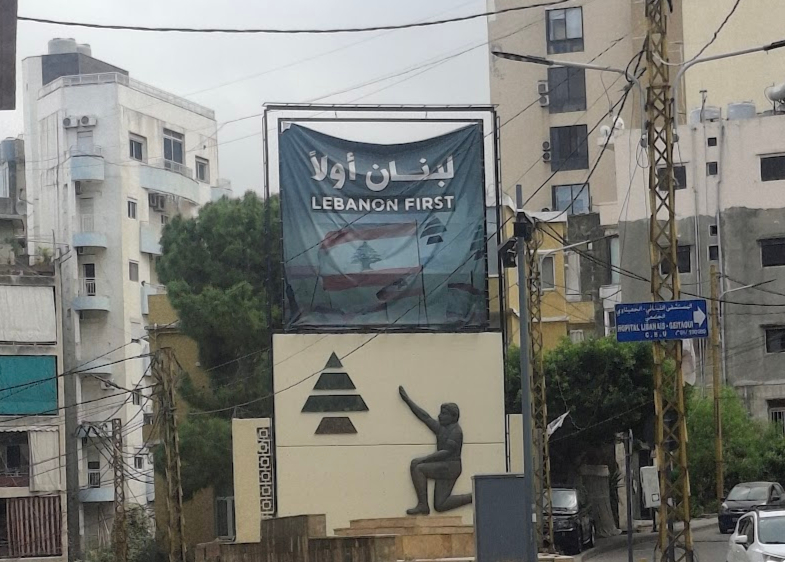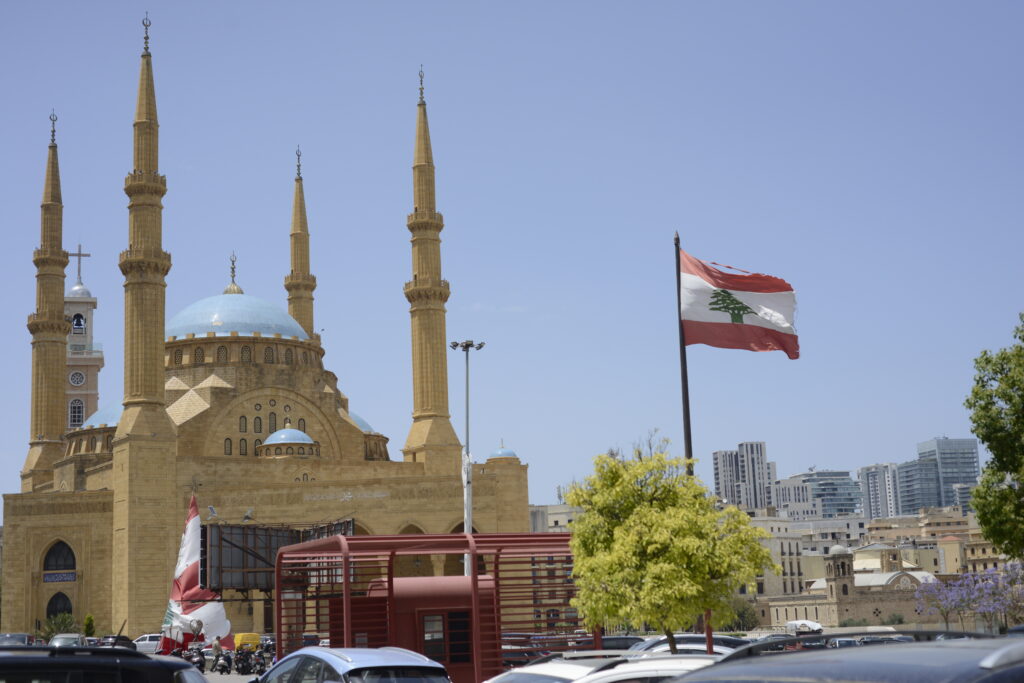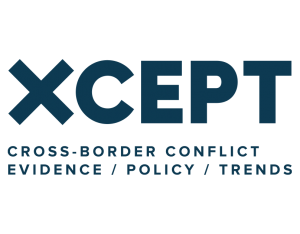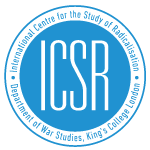By Brontë Philips
*Pseudonyms have been used throughout to protect the identity of those interviewed.
On 9 April 2025, two advertising billboards located on the road to Beirut airport were set on fire, just days after they had been installed.[i] The billboards had displayed a Lebanese flag and the message ‘A New Era for Lebanon’ (عهد جديد للبنان), superimposed onto an aerial image of the Bay of Jounieh. The airport road runs through Dahiyeh, the southern suburbs of Beirut, and has long been adorned with posters commemorating Hezbollah and Lebanese resistance against Israel. Prior to the ‘New Era’ campaign, the same billboards had displayed posters celebrating Hezbollah’s former Secretary General Hassan Nasrallah and former Head of the Executive Council Hashem Safieddine as martyrs, after their assassinations in Israeli airstrikes last year.
![A car drives in front of a poster which displays an aerial image of the Bay of Jounieh, with text and an image of the Lebanese flag superimposed on it. The text reads: عهد جديد للبنان [translates to: A New Era for Lebanon]](https://icsr.info/wp-content/uploads/2025/07/A-new-era-for-Lebanon-airport-road-2-1.jpg)
‘A New Era for Lebanon’ poster on the airport road. Credit: Brontë Philips.
The agency which owns the billboards has not named the new campaign’s sponsor – although the ‘New Era’ slogan likely refers to a statement given by Joseph Aoun after he won Lebanon’s presidential election in January 2025 – and stated that the change in posters was not political. Rather, it was due to the expiry of the existing contract, dated one week after the funerals of Nasrallah and Safieddine in February. Nevertheless, the timing and placement of the new advertising campaign provoked strong reactions. Some viewed the transition as a ‘victory’ in ‘cleaning’ the airport roads of pro-Hezbollah messaging.[ii] For others, the move constituted an attempt to deny the realities of the ongoing conflict. As one Beirut resident reflected, ‘Why [A New Era for Lebanon]? They finally elected a prime minister, so what? What’s this future? As long as Israel exists in Lebanon, we won’t have a future’.
Lebanon has long been divided by a history of sectarianism and violence, and tensions have become exacerbated during the recent conflict with Israel. Just days after the billboards were destroyed, however, the Beirut municipality issued a new initiative to promote a narrative of national unity. On the orders of Lebanon’s Interior Minister Ahmad al-Hajjar, it was announced that all sectarian posters, banners, photos, flags, and advertisements placed on public property along Beirut’s central district were to be removed in order to make Beirut ‘a city free of sectarian and party slogans’.[iii]
As the response to the ‘New Era’ campaign shows, however, Lebanese approaches to memorialisation of the recent past and to the ongoing conflict with Israel are diverse and divisive. By introducing a national narrative of unity, without first seeking to repair existing divisions or address the challenges currently facing Beirut’s population, the government risks exacerbating tensions rather than overcoming them.
Erasing sectarianism
Political images have long been a common feature of Beirut’s urban landscape. Most writings on political Lebanon and memorialisation do not fail to acknowledge the ‘walls continually adorned with banners, posters, portraits immortalising iconic images and infamous slogans, an informal cornucopia of the “living dead”’.[iv] These visual displays are a means by which Beirut’s residents can express loyalty, demonstrate their political identity, and commemorate the dead. However, they also play a role in what Meier has described (in the context of south Lebanon) as ‘borderscaping’: a marking of territory or boundaries through the use of political iconography.[v]
In speaking with a number of residents of Beirut in May 2025, the majority agreed with the decision to remove party political insignia from the capital. This did not seem to be out of a desire to limit expressions of identity. As 34-year-old Farid explained, ‘I totally understand that people want to showcase the loved ones they lost. It’s understandable. I feel like it shouldn’t be on the highways on the main roads. It can be in a more you know like local scale, in a more private manner’.
Instead, approval of the directive was linked to the way in which political imagery in Beirut often represents an expression of power, and a suppression of freedom, in the areas in which it is displayed. Hadi, a 29-year-old Sunni resident of the Hamra district of Beirut, claimed that posters constitute an unofficial demarcation of ‘go’ and ‘no-go’ areas for different sectarian backgrounds: ‘I think it’s a surface issue, but at the same time, I would, personally, when I go into an area and I see that it’s predominantly this group or that group, or if it’s a contested area and one group is trying to impose itself, I do feel a bit tense’.

Kataeb party flag. Credit: Brontë Philips.
Similarly, Hassan, a 23-year-old from a Shi’a family background, remarked that, ‘in my opinion, one of the biggest ways of strong-arming the people in a local area to be afraid of portraying their political opinion is by putting up political posters that claim to represent the entire area’.
The area of the airport road, in this context, is symbolic – not only as a public space, but as one of the first vistas for those entering Lebanon. For some Beirut residents, the removal of party political posters in this iconic gateway to the country constitutes an important representation of Lebanon. As 28-year-old Farah reflected, ‘I don’t think you would feel safe if you see a terrorist picture on a billboard right when you are entering the country. So I think it’s important that they are being removed’.
A new amnesia for Lebanon
In the context of Lebanon’s conflict memory, however, the removal of party political posters, and the promotion of ‘A New Era for Lebanon’, can also be interpreted as a continuation of what Khalaf has described as the ‘collective amnesia’ of post-civil war Lebanon.[vi] The Ta’if Agreement, signed in 1989 to mark the end of the conflict, effectively imposed a policy of state-sponsored silence on the violence of the civil war.[vii] It implemented a power-sharing arrangement which reinforced the political sectarianism of the civil war and empowered the same elites who were responsible for violence to control the narratives of that violence. The subsequent amnesty law, which pardoned many of the same sectarian leaders, meant that the conflict had no public resolution.
Yet, rather than contain and suppress the collective trauma of the civil war, the state-imposed silence created a memory vacuum which, in turn, facilitated a proliferation of memory cultures. Today, these competing narratives continue to maintain and perpetuate tensions among the population. For some, both the new advertising campaign – which has been rolled out across Beirut – and the directive, were believed to be another attempt to erase the realities of conflict and division in Lebanon. As 30-year-old Mona observed, ‘you can’t remove the political parties from Lebanon. You can’t remove the support, the years of integration, and the years of brainwashing. You cannot remove that by taking down a few posters’.
Similarly, with the ‘New Era’ campaign functioning as a (literal) plastering over of the wounds of conflict with Israel, it seems to some as though they are being encouraged to forget their experiences of the recent, and ongoing, hostilities. This deprives people not only of a chance to address their trauma, but to take steps to begin to heal. Mona viewed the promotion of a new collective narrative of unity as an official silencing of trauma which ‘denies us time to grieve over what just happened’.
As well as ignoring existing issues, there is a concern that the new initiatives could reignite schisms. 28-year-old Ali, a Shi’a resident of Beirut, expressed fears that the efforts to remove political insignia could backfire: ‘I think in general, regulations would not solve the issues, but it would create suppression that would lead to more extremist [views] – especially when one sect feels that it’s a victim during and after the war’. In this case, attempts to promote a facade of unity may in fact deepen feelings of exclusion, as they deny the population the chance to hold an honest dialogue about the scars of recent conflict memory.

Martyrs’ Square, looking towards Al-Amin mosque. Credit: Brontë Philips.
‘A surface issue’
Even among those who agreed with the municipality’s efforts to remove party political iconography, many were sceptical about whether the initiative would be effective. The directive does not constitute a removal of images across the whole of Beirut. Posters celebrating the Kataeb party remain in several areas, while images of Bashir Gemayel, as well as Lebanese Forces flags and icons, are still displayed in areas such as Achrafieh. In some cases, while party flags are taken down, images of leaders, such as Nasrallah and Nabih Berri, remain. As Hadi recalled, ‘10 years ago they did the same thing. There was a thawing of ties between the Future Movement and Hezbollah, and they didn’t fix any of their primary disagreements, but they agreed to remove their posters … this lasted maybe a month or two before all the posters started to reappear magically’.
Hadi also expressed doubt as to whether the removal of sectarian signs would contribute to any rehabilitation of social divides, particularly where these had been exaggerated in the wake of the recent conflict with Israel: ‘I’m pretty sure they have other avenues of brainwashing those people … Not just Hezbollah, the Christians, the Sunnis. They have other avenues: schools, clubs, scouts. That’s why I think it’s just like a surface issue, and I’m sure they’re going to be back as soon as the going gets tough, those posters’.
The ‘New Era’ campaign, while celebrated by some as a reclamation of national sovereignty, has also increased feelings of disillusionment towards the new administration. With the government seemingly choosing to tackle the country’s divisions on a superficial level only, many of Beirut’s residents feel let down. As one social media user wrote on X, ‘No one has time for martyrs, reconstruction, the South or the occupation … [Some] are busy decorating the airport road so tourists can enjoy their stay in Lebanon’. Likewise, Hadi claimed that ‘I just think it’s a very cheap gimmick to attract tourists, and this is just another thing that I’m bothered with, that the government cares more about tourists than its own people’.
![A photo taken through a car window shows a poster which displays an aerial image of the Bay of Jounieh, with text and an image of the Lebanese flag superimposed on it. The text reads: عهد جديد للبنان [translates to: A New Era for Lebanon]](https://icsr.info/wp-content/uploads/2025/07/A-new-era-for-Lebanon-airport-road-2-1-1.jpg)
‘A New Era for Lebanon’ poster on the airport road. Credit: Brontë Philips.
‘How very Lebanese of us, to turn the page’
The new initiatives may signal hope for a change in Lebanon’s circumstances, but many of those interviewed feel these displays of optimism are premature and fail to address the reality of the situation. Despite the ceasefire agreed in November last year, Israel still occupies five positions in Lebanon and continues to launch airstrikes at what it claims are Hezbollah targets.[viii] Lebanon is also desperately seeking funding to support its recovery and reconstruction, which is projected to cost around $11billion USD.[ix] It is not clear how, or when, Lebanon can build a more stable and unified future. As Hassan highlighted, ‘there is a lot of steps you need to do before tearing down the political posters and replacing them with ultra optimistic “yeh we’re coming back blah blah” posters … you’re not going to wave a magic wand and make Lebanon great again. The people are hurt, they’re tired, they’re injured’.
For Mona, the initiatives are simply another attempt to incorporate the current conflict with Israel into a cycle of violence, forgotten and re-remembered: ‘I think that, as Lebanese people, we’re always trying to start over, and we’re always trying to push everything under the rug. We’ve seen it with the civil war. We’ve seen it with the 2006 [Israel-Lebanon] war. We’ve seen it with this war … how very Lebanese of us, to turn the page’. If the Lebanese state wants the visual displays of unity to truly reflect the reality on the ground, it cannot simply paper over its divisive history. Instead, it must work to promote an honest and inclusive dialogue amongst its population, and allow the Lebanese people to openly share their memories and experiences of conflict to allow them to move forward.
Don’t forget to follow our new Centre for Statecraft & National Security (CSNS) LinkedIn page to stay up to date with our research.
[i] Blondel, G. (2025, 11 April). ‘What to know about the burned advertising posters on the airport road,’ L’Orient Today, https://today.lorientlejour.com/article/1455712/what-to-know-about-the-burned-advertising-posters-on-the-airport-road.html
[ii] Ibid.
[iii] Hamadi, G. (2025, 16 April). ‘Beirut begins removal of all religious and political banners,’ L’Orient Today. https://today.lorientlejour.com/article/1456243/beirut-begins-removal-of-all-banners.html
[iv] Larkin, C. (2012). Memory and conflict in Lebanon: Remembering and Forgetting the Past. Routledge, 192.
[v] Meier, D. (2015). From Frontline to Borderscape: The Hizbullah Memorial Museum in South of Lebanon. In C. Brambilla, J. Laine, J. W. Scott, & G. Bocchi (Eds.), Borderscaping: Imaginations and Practices of Border Making (pp. 77-86). Routledge.
[vi] Khalaf, S. (1994). Culture, Collective Memory, and the Restoration of Civility. In D. Collings (Ed.), Peace for Lebanon?: From War to Reconstruction (pp. 273-286). Lynne Rienner Publishers.
[vii] Young, M. (2000). The Sneer of Memory: Lebanon’s Disappeared and Postwar Culture. Middle East Report (New York, N.Y. 1988), 30(217), 42–45. https://doi.org/10.2307/1520176
[viii] ACLED. (2025, 8 May). ‘Regional Overview Middle East May 2025’. ACLED. https://acleddata.com/2025/05/08/middle-east-overview-may-2025/
[ix] World Bank. 2025. “Lebanon Rapid Damage and Needs Assessment (RDNA).” Washington, DC: The World Bank. Accessed at: https://documents1.worldbank.org/curated/en/099030125012526525/pdf/P506380-f58e9761-b29e-4d62-97c3-ebf5a511c4e1.pdf

This publication was produced as part of the XCEPT programme, a programme funded by UK International Development from the UK government. The views expressed do not necessarily reflect the UK government’s official policies.

